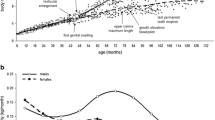Abstract
Age differences in food intake and dietary selection were studied for 8 months among wild male Japanese macaques (Macaca fuscata) under non-predatory situations. Juveniles' feeding time was longer than adult males' in some months, in particular in mating seasons, but did not differ in the other months. Juveniles' feeding speed was slower than that of adult males. However, the age difference in average feeding speed was smaller (90%) than that in expected daily energy expenditure (62–58%). The extent of age difference in feeding speed varied with the food type: the difference was large for fibrous foods, but small for fruits or seeds. As a consequence of the age differences in time spent feeding and feeding speed, the age difference in daily food intake was smaller than expected from metabolic demands. Thus, the hypothesis that juveniles are more vulnerable to starvation than adults was not supported among male Japanese macaques in predator-free Yakushima. Juveniles ate more animal matter, while adult males ate more fibrous foods.





Similar content being viewed by others
References
Agetsuma N (1995a) Foraging synchrony in a group of Yakushima macaques (Macaca fuscata yakui). Folia Primatol 64:167–179
Agetsuma N (1995b) Foraging strategies of Yakushima macaques (Macaca fuscata yakui). Int J Primatol 16:595–609
Agetsuma N (2001) Relation between age-sex classes and dietary selection of wild Japanese monkeys. Ecol Res 16:759–763
Alberts SC, Altmann J, Wilson ML (1996) Mate guarding constraints foraging activity of male baboons. Anim Behav 51:1269–1277
Altmann J (1974) Observational study of behavior: sampling methods. Behaviour 49:227–267
Boinski S (1988) Sex differences in the foraging behavior of squirrel monkeys in a seasonal habitat. Behav Ecol Sociobiol 23:177–186
Byrne RW, Whiten A, Henzi SP, McCulloch FM (1993) Nutritional constraints on mountain baboons (Papio ursinus): implications for baboon socioecology. Behav Ecol Sociobiol 33:233–246
Calder WA (1984) Size, function and life history. Harvard University Press, Cambridge, Mass.
Gaulin SJC (1979) A Jarman/Bell model of primate feeding niches. Hum Ecol 7:1–20
Harrison MJS (1983) Age and sex differences in the diet and feeding strategies of the green monkey, Cercopithecus sabaeus. Anim Behav 31:969–977
Hill DA (1997) Seasonal variation in the feeding behavior and diet of Japanese macaques (Macaca fuscata yakui) in lowland forest of Yakushima. Am J Primatol 43:305–322
Iwamoto T (1982) Food and nutritional condition of free ranging Japanese monkeys on Koshima Islet during winter. Primates 23:153–170
Iwamoto T (1988) Food and energetics of provisioned wild Japanese macaques (Macaca fuscata). In: Fa JE, Southwick CH (eds) Ecology and behavior of food-enhanced primate groups. Liss, New York, pp 79–94
Janson CH (1990) Ecological consequences of individual spatial choice in foraging groups of brown capuchin monkeys, Cebus apella. Anim Behav 40:922–934
Janson CH, van Schaik CP (1993) Ecological risk aversion in juvenile primates: slow and steady wins the race. In: Pereira ME, Fairbanks LA (eds) Juvenile primates. Oxford University Press, New York, pp 57–74
Kleiber M (1987) The fire of life. Krieger, Malabar, Fla
Nakayama Y, Matsuoka S, Watanuki Y (1999) Feeding rates and energy deficits of juvenile and adult Japanese monkeys in a cool temperate area with snow coverage. Ecol Res 14:291–301
Portman OW (1970) Nutritional requirements (NRC) of nonhuman primates. In: Harris RS (ed) Feeding and nutrition of nonhuman primates. Academic Press, London, pp 87–115
Schaik CP van, van Noordwijk MA (1986) The hidden cost of sociality: intra-group variation in feeding strategies in Sumatran long-tailed macaques (Macaca fascicularis). Behaviour 99:296–315
Shipley LA, Gross JE, Spalinger DE, Hobbs NT, Wunder BA (1994) The scaling of intake rate in mammalian herbivores. Am Nat 143:1055–1082
Vries J de, van Eerden MR (1995) Thermal conductance in aquatic birds in relation to the degree of water contact, body mass, and body fat: energetic implications of living in a strong cooling environment. Physiol Zool 68:1143–1163
Watanabe T (1975) Some features of the wild Japanese monkeys (Macaca fuscata) of Shiga A troop from viewpoint of somatometry. Physiol Ecol 16:55–63 (in Japanese with English summary)
Watts DP (1988) Environmental influences on mountain gorilla time budgets. Am J Primatol 15:195–211
Yamagiwa J, Hill DA (1998) Intraspecific variation in the social organization of Japanese macaques: past and present scope of field studies in natural habitats. Primates 39:257–273
Acknowledgements
I would like to thank my friends and colleagues in Yakushima for their hospitality and help. I am also grateful for Yakushima Forest Environment Conservation Center for permission to undertake the research. Sarugoya-Committee and Field Research Center of Primate Research Institute, Kyoto University (PRIKU) offered me excellent facilities. Drs. T. Nishida, J. Yamagiwa, N. Agetsuma, D.A. Hill, H. Ihobe, S. Suzuki, Y. Watanuki, N. Nakagawa, an anonymous referee, and members at Laboratory of Human Evolution Studies, Kyoto University offered me helpful suggestions and comments on the manuscript. This study was financed in part by Cooperation Research Program of PRIKU and the MEXT Grant-in-Aid for the 21st Century COE Program (A2) and for Scientific Research for JSPS Fellows.
Author information
Authors and Affiliations
Corresponding author
About this article
Cite this article
Hanya, G. Age differences in food intake and dietary selection of wild male Japanese macaques. Primates 44, 333–339 (2003). https://doi.org/10.1007/s10329-003-0047-7
Received:
Accepted:
Published:
Issue Date:
DOI: https://doi.org/10.1007/s10329-003-0047-7




